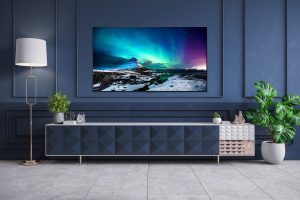Introduction to 4K and 8K TV Technology
The world of television technology has seen rapid advancements over the years. The transition from black and white to color, analog to digital, and now the shift from standard definition to high definition (HD), 4K, and 8K has significantly transformed the viewing experience. This article will delve into the realm of 4K TV and 8K TV technology, providing a comprehensive guide to understanding the real difference between 4K and 8K.
The terms 4K and 8K refer to the horizontal screen resolution. In simpler terms, they represent the number of pixels (tiny dots) that make up the images on the screen. With more pixels, the image becomes more detailed and sharper. The advent of 4K and 8K technology brought about a revolution in the television industry. However, many consumers are still unsure about what these terms mean and how they impact the quality of their viewing experience.
This confusion is understandable given the technical jargon and the numerous factors that come into play when discussing screen resolution. This guide aims to demystify these terms and explain the difference between 4k and 8k tv technology in a simplified and digestible manner.
4K resolution in televisions refers to the horizontal screen display resolution of approximately 4,000 pixels. Technically, the standard resolution for 4K is 3840 x 2160 pixels. This means that a 4K TV screen has 3840 pixels horizontally and 2160 pixels vertically. This results in a total of over 8 million pixels, which is four times the pixel count of a full HD (1080p) TV.
This significant increase in pixel count results in a much sharper and more detailed image. In a 4K TV, the images are incredibly clear, even in fast-moving scenes. This is because each pixel is smaller and can therefore display more detail. The result is an image that is so detailed that it almost seems like you are looking through a window.
4K technology has been widely adopted in the television industry, with many manufacturers now producing 4K TVs. The content available in 4K resolution has also increased, with many streaming platforms, such as Netflix and Amazon Prime Video, offering 4K content.
8K resolution in televisions is the next step in the evolution of screen resolution. An 8K TV has a resolution of 7680 x 4320 pixels. This translates to over 33 million pixels, which is four times the number of pixels in a 4K TV and 16 times more than a full HD TV.
The increased pixel count in 8K TVs results in an even sharper and more detailed image than 4K. However, the difference may not be as noticeable to the human eye, especially on smaller screens or from a far viewing distance. Despite this, the potential of 8K resolution is immense, particularly when it comes to large-scale displays and immersive viewing experiences, like virtual reality.
The adoption of 8K technology in the television industry is still in its early stages. While there are 8K TVs available in the market, they are relatively expensive, and the availability of 8K content is currently limited.
The Real Difference Between 4K and 8K
The primary difference between 4K and 8K lies in the number of pixels. An 8K TV has four times the number of pixels as a 4K TV. This results in a more detailed and sharper image. However, the human eye may not be able to discern this difference, especially on smaller screens or from a far viewing distance.
Another key difference between 4K and 8K technology is in the availability of content. While there is a growing library of 4K content, 8K content is still quite limited. This means that even if you own an 8K TV, you may not be able to fully utilize its potential due to the lack of available content.
Lastly, 8K TVs are significantly more expensive than 4K TVs. This is because the technology is still new and not as widely adopted. As the technology matures and becomes more popular, the prices are expected to come down, making 8K TVs more accessible to the general public.
Can You Tell the Difference Between 4K and 8K?
One of the most common questions that consumers ask is, “Can you tell the difference between 4K and 8K TV?” The answer to this question is not straightforward as it depends on various factors such as the size of the screen, the viewing distance, and the quality of the content.
In general, the human eye may not be able to perceive the difference between 4K and 8K on smaller screens or from a far viewing distance. This is because the pixels on a 4K or 8K TV are already so small that they are near the limit of what the human eye can resolve.
However, on larger screens or from a closer viewing distance, the difference becomes more noticeable. The increased level of detail and sharpness in 8K TVs can result in a more immersive and realistic viewing experience.
Comparing 4K and 8K TVs
When comparing 4K and 8K TVs, it’s important to consider not only the difference in resolution but also other factors such as the availability of content, the price, and the future-proofing potential.
In terms of resolution, 8K TVs definitely have the upper hand. They offer four times the number of pixels as 4K TVs, resulting in a much more detailed and sharper image. However, this difference may not be noticeable unless you are viewing on a large screen or from a close distance.
In terms of content, 4K TVs currently have the advantage. There is a growing library of 4K content available, while 8K content is still quite limited. However, this is likely to change in the future as more 8K content becomes available.
In terms of price, 4K TVs are currently more affordable than 8K TVs. However, as the technology matures and becomes more widely adopted, the prices of 8K TVs are expected to come down.
Finally, in terms of future-proofing, 8K TVs have the potential to be a better investment. As more 8K content becomes available, owning an 8K TV will allow you to take full advantage of this content.
Factors That Affect the Difference Between 4K and 8K TVs
Several factors can affect the perceivable difference between 4K and 8K TVs. These include the screen size, the viewing distance, the quality of the content, and the individual viewer’s eyesight.
The screen size is a critical factor. The larger the screen, the more noticeable the difference between 4K and 8K becomes. This is because a larger screen can display more of the added detail that comes with higher resolution.
The viewing distance also plays a significant role. The closer you are to the screen, the more noticeable the difference between 4K and 8K will be. This is because the human eye can only resolve a certain amount of detail. If you are sitting too far from the screen, the added detail of 8K may not be perceivable.
The quality of the content is another important factor. If the content you are viewing is not produced in 8K, you will not be able to fully utilize the potential of an 8K TV. Similarly, if the content is poorly produced, the higher resolution will not improve the viewing experience.
Finally, the individual viewer’s eyesight can also influence the perceivable difference between 4K and 8K. Some people may not be able to discern the added detail of 8K due to limitations in their eyesight.
How to Choose Between 4K and 8K Technology
Choosing between 4K and 8K technology largely depends on your individual needs and circumstances. If you have a large viewing area and sit relatively close to the screen, you might benefit from the added detail of 8K. Similarly, if you want to future-proof your TV for when more 8K content becomes available, an 8K TV could be a good investment.
On the other hand, if you have a smaller viewing area, sit far from the screen, or have budget constraints, a 4K TV may be more suitable. It will still provide you with a high-quality viewing experience, and there is plenty of 4K content available.
When making your decision, remember to consider the availability of content, the price, and the potential for future-proofing. Also, consider the size of your viewing area, your viewing distance, and your own eyesight. It’s also a good idea to view different 4K and 8K TVs in person to see if you can perceive the difference.
Future of 4K and 8K Technology
The future of 4K and 8K technology looks promising. As technology continues to advance, the adoption of 8K is expected to increase, and the prices are likely to come down. This will make 8K TVs more accessible to the general public.
Furthermore, the availability of 8K content is also expected to increase. As more filmmakers and content creators start producing in 8K, viewers will be able to fully utilize the potential of their 8K TVs.
4K technology is also expected to continue evolving. With the advent of technologies like HDR (High Dynamic Range), the image quality on 4K TVs can be further enhanced.
Conclusion
Understanding the difference between 4k and 8k is key to making an informed decision when buying a new TV. While 8K offers a higher resolution, the difference may not be noticeable under certain conditions. Other factors such as the availability of content, the price, and future-proofing potential should also be considered.
Whether you choose a 4K or 8K TV will ultimately depend on your individual needs and circumstances. Centre Hi Fi has experts at its stores that can help you select the right TV based on your needs. You can also check out our guide on the best 4K smart TVs for 2024.
Visit Centre Hi Fi store today to see the largest collection of 4K smart TVs and make the best choice for your viewing experience.

TELEVISIONS

SOUNDBARS

TURNTABLES & VINYL

HEADPHONES

SPEAKERS

STEREO COMPONENTS

AV COMPONENTS

PROJECTORS

BLUETOOTH SPEAKERS

CABLES & ACCESSORIES

BRACKETS & STANDS

Non classé
![]() !!!!CALL US FOR YOUR SPECIAL PRICES NOW!!!!
!!!!CALL US FOR YOUR SPECIAL PRICES NOW!!!!![]() !!!! CANADIAN OWNED AND OPERATED !!!!
!!!! CANADIAN OWNED AND OPERATED !!!!






























